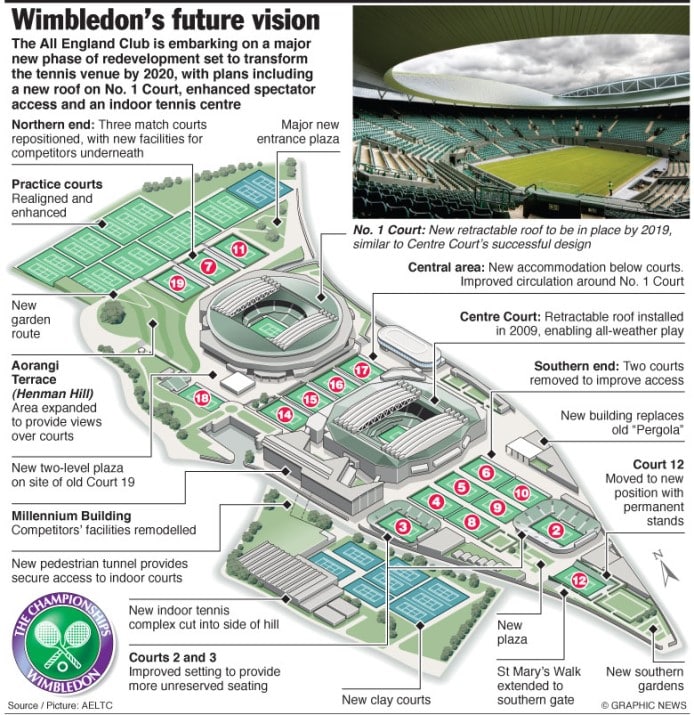
Tennis is one of the most widespread recreational and professional sports in the world. It is also an Olympic sport and a very popular worldwide spectator sport viewed by millions of fans. It is usually played by two players (singles) or two teams with two players on each team (doubles). It is played on a court, which is equally divided by a net that stretches across the full width of the court. The players use a racket (also racquet) to strike a hollow felt-covered rubber ball over the net to the opponent’s side of the court. The goal is to play the ball in such a way that the opponent is not able to return the ball. A player wins a point when the opponent cannot return a shot or the opponent’s shot doesn’t land in the court. This sport can be played by people of all ages, including people in wheelchairs.
The tennis court is a rectangular court with grass, clay or hard-court surface of concrete, asphalt or carpet indoors. It is 23.77 m long and 8.23 m wide for singles matches and 10.97 m wide for doubles matches. It is divided by lines into different areas. The baselines are the farthest back along the width of the court and the sidelines are in the middle of the court. There are four ‘service boxes’ in the center of the court in which the serves must land. The net is 1.07 m high at the posts and little lower (0.917 m) in the middle.
A tennis match
Players start on opposite sides of the net. One player starts as the server and the other as a receiver. This is decided by a toss. The service alternates between the players or teams game by game. The server starts behind the baseline (behind the center mark and sideline) and serves the ball to his opponent (standing anywhere on his/her side of the court). If the serve is good, the receiver must hit the ball back into the server’s side of the court.
The serve is good if the ball goes over the net (without touching it) and lands into the diagonally opposite service box. The ball is out if it does not hit the line or the area inside the lines on first bounce. If the ball hits the net, but lands in the service box, the server can serve again. A fault is a serve when the ball falls outside the lines or does not go over the net. After two faults (double fault) the point goes to the receiver.
Players return the ball to each other until one of them scores a point but a player or a team cannot hit the ball twice in a row.
A tennis match consists of sets. A set consists of games. Games consist of points.
The points are counted love (0), fifteen (15), thirty (30) and forty (40). If both players get 40 points, the score is called deuce and the players need two more points to win the game. The first player who wins at least four points in total and at least two more points than the opponent wins a game. The result of a tennis match is determined by the best of three (or five sets).
To win a set, a player or a team must be the first to win at least six games. The first player or team to win two sets from a best-of-three-set match or three sets from a best-of-five-set match is the winner.
Did you know? Love originates from the French word l’oeuf, which means egg, which is round as a zero.
Different kinds of shots
There are many different kinds of way to hit the ball in tennis. There is the serve, the forehand, backhand, volley, half-volley, overhead smash, drop shot and lob. Professional tennis players also put spins on their shots to make them more difficult to return.
Forehand shot: The easiest and usually the first shot a tennis player learns. You swing the racquet across the body on the same side as the hand that holds the racquet.
Backhand: The opposite of the forehand. You swing the racquet away from the body holding the racquet in one or both hands.
Volley: This is the shot that is made without the ball bouncing on the ground.
Half-volley: The ball is hit on the rise right after it bounces.
Overhead smash: A powerful shot that is hit over the head in a serve-like motion.
Drop shot: A trick-shot when the opponent is far back in the court and the player hits the ball softly just over the net so it bounces twice before the other player can reach it.
Lob: When a player hits the ball high and deep into the opponent’s court.
——————————————————-
widespread – széleskörűen elterjedt
recreational – rekreációs, szórakozási
worldwide – az egész világon (elterjedt)
spectator – néző
equally – egyenlő arányban
to divide – (el/fel)osztani
net – háló
to stretch – (ki)terjedni, húzódni
width – szélesség, széle valaminek
racket – ütő
to strike – ütni, (le)csapni
hollow – üreges
felt-covered – nemezzel borított/fedett
rubber ball – gumilabda
opponent – ellenfél
to return the ball – visszaadni a labdát
to land – landolni, érkezni
wheelchair – kerekesszék
rectangular – téglalap alakú
clay – (itt) salakos
hard-court – keménypálya
surface – felszín, felület
concrete – beton
baseline – alapvonal
sideline – oldalvonal
service boksz – adogató udvar
serve – szerva
post – oszlop, rúd
opposite – ellentétes, ellenkező
server – adogató
receiver – fogadó
toss – feldobás
to alternate – váltakozni
bounce – lepattanni
love – (itt) nulla
deuce – (itt) egyenlő, negyven mind
to determine – meghatározni
forehand – tenyeres
backhand – fonák
volley – röpte
overhead smash – lecsapás
drop shot – rövidítés
lob – (át)emelés
spin – pörgés, forgés, csavar
to swing – (meg)lendíteni, lendület
rise – emelkedés
ALL ABOUT WIMBLEDON
KLIKKELJ A KÉPRE!




